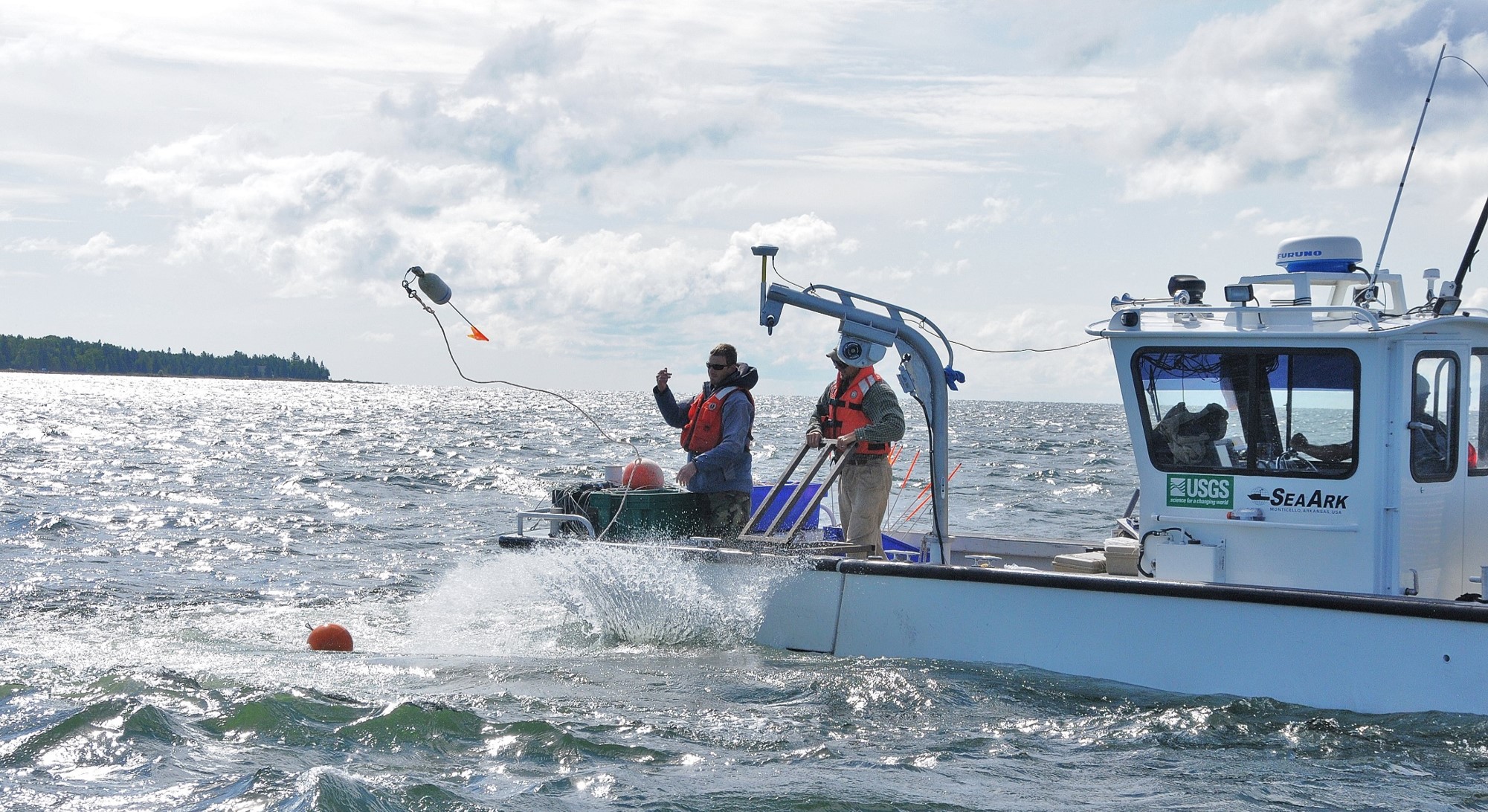Fish-tracking network grows strong under leadership of MSU Fisheries and Wildlife professor
Chris Vandergoot is the director of the Great Lakes Acoustic Telemetry Observation System (GLATOS), which brings together researchers and fishery managers alike who use sound to monitor fish.
East Lansing, Mich. — When driving on turnpikes, some people mount E-ZPass transponders to their car windshields so they can use special lanes that allow drivers to pass through without stopping at traditional highway tollbooths. The car transponders are radio frequency devices that are detected by antennas underneath the E-ZPass signs vehicles travel under. As they enter and exit the lanes, travel information is recorded by the transponders.
In the Great Lakes, populations of fish are managed in a similar way.
Chris Vandergoot, an associate professor in Michigan State University’s Department of Fisheries and Wildlife, is the director of the Great Lakes Acoustic Telemetry Observation System, or GLATOS.

He said acoustic telemetry allows fish to be tracked and monitored using sound. This process occurs using two pieces of equipment: acoustic transmitters surgically tagged within fish, and acoustic receivers stationed underwater.
“We’re putting transmitters in these fish — some are as small as a Tic Tac, and some are as large as a double-A battery,” Vandergoot said. “The other component to acoustic telemetry, unlike other telemetry systems, is receivers are deployed underwater. Whether they’re in a river or a lake, they’re sitting there listening for fish to swim by and for that transmitter code to go off.”
After tagged fish swim by the receivers, data is collected and stored by the receivers for researchers to analyze.
Founded in 2010, GLATOS operates underneath the Great Lakes Fishery Commission. It’s a research collaborative made up of fishery organizations from the U.S. and Canada, including academic, First Nation, provincial and state sectors.
Tracking fish movement allows researchers to better understand not only how fish behave in the Great Lakes, but also how to manage and stock their populations.
The network of projects worked on through GLATOS allows for ample opportunity for data to be shared among members. If members have questions about their project or are interested in comparing data from other projects, they can use the data portal and obtain information from projects that’ve been previously uploaded. They can also connect with collaborators directly.
“That’s another function of GLATOS — in addition to facilitating this online database, we also try to link researchers up,” Vandergoot said. “For example, if somebody is working with one type of fish population in a lake and somebody else is tracking a different type, one (population) may be a predator, and one may be a prey. So, our members can collaboratively work together to monitor how their fish interact.”
Before GLATOS, acoustic telemetry was — and still is — an important surveillance tool in rivers and small lakes. However, it had not yet been introduced within larger water ecosystems.
“The question was: ‘Would this even be feasible to replicate in the Great Lakes?’” Vandergoot said.
To test the capability of acoustic telemetry in the Great Lakes, the emergent GLATOS network began four projects in 2010 that observed four different fish species: lake trout, lake sturgeon, sea lamprey and walleye. Roughly 100 receivers were used.
Today, GLATOS supports over 100 different projects with about 2,500 receivers set throughout the Great Lakes.
Marc Gaden, the deputy executive secretary of the Great Lakes Fishery Commission, said the addition of acoustic telemetry in the Great Lakes has been a “gamechanger” for how fish are observed and managed.
“Acoustic telemetry has taken us from the Middle Ages to a very different place in terms of understanding how fish move and behave,” Gaden said. “It’s really changed things.”
The current priorities of many GLATOS members include pressing management needs for lake whitefish and walleye in response to recreational commercial fishing, which mostly occurs in Lake Huron and Lake Erie. Mortality rates and movement rates of fish, data collected by the subaquatic receivers, contribute to the decision behind what needs are pressing.

Some projects focus on simply understanding populations of fish better, like examining lake trout in Lake Superior. Lake trout is the top predator in Lake Superior, and it comes in three types: the humper lake trout, lean lake trout and siscowet lake trout. Vandergoot said each type inhabits different depths and niches of the lake, so researchers use acoustic telemetry to map where they can be found at specific times of the year.
Other projects aim to reintroduce species of fish that were suppressed years ago due to overfishing and habitat degradation — like Great Lakes coregonids, small bait fish that other fish rely upon as food. Acoustic telemetry, in this case, provides information that allows researchers to determine what time of day, what body of water and what size of fish to stock at for the best chances of survival.
Max Majinska, a master’s student in MSU’s Department of Fisheries and Wildlife, uses acoustic telemetry to examine lake sturgeon’s movement in the Cass, Flint, Shiawassee and Tittabawassee rivers. All lead into the Saginaw River, which flows into Saginaw Bay of Lake Huron.
After being considered extirpated — or eradicated — from the areas it once inhabited, lake sturgeon was reintroduced to these rivers in 2017. The questions Majinska is now trying to answer are: How do stocked sturgeon utilize this system, especially with open access to Lake Huron, and what are the survival rates after one year?
“It’s an important question for us so we can understand how lake sturgeon use these systems and what areas of the habitat we either need to protect or restore,” Majinska said. “We’re trying to bring back the population, so from a management perspective, it’s important to know how many (age-0) fish survive after we stock them — particularly in a species that can take upward of 25 years to begin spawning.”
Majinska, who surgically implants tags the size of a pinky fingertip within baby lake sturgeon, said because the process of restoring these fish began only a few years ago, he’s unsure what type of data to expect when retrieving the receivers.
“There are very few systems left within the Great Lakes that still have remnant populations of lake sturgeon, so it’s a guessing game as to what the renewed population will do,” he said. “There’s a lot of individual behavior in these fish. Each one has a slightly different personality in making its home, finding food and protecting itself from predators. The system is relatively novel to them, so they’re just figuring everything out.”
GLATOS members bring the receivers in rivers up to the water’s surface every few months to download data and change their batteries. In the Great Lakes, receivers are usually recovered once a year.
Some receivers have advanced so far that they can track fish in real time without being pulled out of the water. Gaden said this adds to an important educational aspect of GLATOS.
“You could have a classroom of kids that could get on the internet and see where their fish are today,” Gaden said.
One area this technology is being piloted is in Lake Michigan near Chicago in partnership with the Shedd Aquarium.
There are other methods to tag fish. Jaw and anchor tags, for example, are plastic markers that are respectively clipped near the jaw or fin. They’re more permanent compared to those used for acoustic telemetry and can last with a fish for its lifetime. Sometimes, they can also be more difficult to detect.
Vandergoot said each type of tag can be useful depending on the research being conducted. However, he noted that acoustic telemetry has sped up the process of pulling together data and sharing it across the GLATOS network.
“Historically, we’d tag fish, release them and might not see them for 10 years,” Vandergoot said. “It took a long time to get enough data on those fish.
“Now, with acoustic telemetry, we’re seeing fish on regular intervals. We’re seeing walleye on the Lake Erie and Lake Huron receivers once a week. We’re watching them move down the lakes, turn around and move back.”
Going forward, Vandergoot said he’d like to better incorporate ways of collating fish data with the data of what’s occurring in the lakes. Specifically, he’d like to further explore how fish react to climatic events.
“Do fish alter their behavior during the summer as the water gets warmer and the nutrients get richer?” Vandergoot asked. “Do they stay in the area, or do they vacate and follow that pocket of water that has more suitable oxygen?
“That’s the next step — linking fish movements to what’s going on with the abiotic conditions of the lake.”
Michigan State University AgBioResearch scientists discover dynamic solutions for food systems and the environment. More than 300 MSU faculty conduct leading-edge research on a variety of topics, from health and climate to agriculture and natural resources. Originally formed in 1888 as the Michigan Agricultural Experiment Station, MSU AgBioResearch oversees numerous on-campus research facilities, as well as 15 outlying centers throughout Michigan. To learn more, visit agbioresearch.msu.edu.



 Print
Print Email
Email




